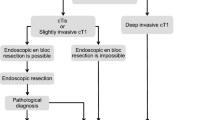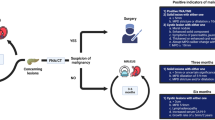Abstract
Background and aim
In standard colonoscopy, the colonoscope is inserted into the cecum, and inspection of the colonic mucosa and polypectomy are performed during withdrawal. The colon configuration can differ between the insertion and withdrawal phases, and some polyps found in the insertion phase can be missed during withdrawal. A few single-center studies investigated whether detection of polyps during the insertion phase affects the adenoma detection rate (ADR). However, the effectiveness of this strategy is unknown because of conflicting results. We aimed to determine whether polypectomy together with careful inspection during insertion increases the ADR compared with standard colonoscopy.
Methods
A randomized, controlled, multicenter trial was conducted at three university hospitals. Patients aged 50 to 80 years were randomly assigned to the study group or control group. For patients in the study group, polypectomy was performed together with careful inspection during both colonoscope insertion and withdrawal. In the control group, polyps were inspected and removed only during colonoscope withdrawal. The primary endpoint was the ADR, which was defined as the percentage of patients with ≥ 1 adenoma.
Results
A total of 1142 patients were enrolled (study group, n = 571; control group, n = 571). The ADR was similar in the 2 groups (study group, 44.1%; control group, 43.1%; P = 0.72). In the control group, 12 polyps that had been detected during colonoscope insertion were not found during withdrawal (polyp miss rate: 2.1%, 12/571).
Conclusion
Polypectomy and careful inspection during both colonoscope insertion and withdrawal did not improve the overall ADR compared with standard colonoscopy (NCT01925833).

Similar content being viewed by others
References
Yoon JY, Cha JM, Jeen YT, Medical Policy Committee of Korean Association for the Study of Intestinal Diseases (KASID), Quality Improvement Committee of Korean Society of Gastrointestinal Endoscopy (KSGE) (2018) Quality is the key for emerging issues of population-based colonoscopy screening. Intest Res 16:48–54
Zauber AG, Winawer SJ, O'Brien MJ, Lansdorp-Vogelaar I, van Ballegooijen M, Hankey BF, Shi W, Bond JH, Schapiro M, Panish JF, Stewart ET, Waye JD (2012) Colonoscopic polypectomy and long-term prevention of colorectal-cancer deaths. N Engl J Med 366:687–696
Pan J, Xin L, Ma YF, Hu LH, Li ZS (2016) Colonoscopy reduces colorectal cancer incidence and mortality in patients with non-malignant findings: a meta-analysis. Am J Gastroenterol 111:355–365
van Rijn JC, Reitsma JB, Stoker J, Bossuyt PM, van Deventer SJ, Dekker E (2006) Polyp miss rate determined by tandem colonoscopy: a systematic review. Am J Gastroenterol 101:343–350
Kim NH, Jung YS, Jeong WS, Yang HJ, Park SK, Choi K, Park DI (2017) Miss rate of colorectal neoplastic polyps and risk factors for missed polyps in consecutive colonoscopies. Intest Res 15:411–418
Robertson DJ, Lieberman DA, Winawer SJ, Ahnen DJ, Baron JA, Schatzkin A, Cross AJ, Zauber AG, Church TR, Lance P, Greenberg ER, Martinez ME (2014) Colorectal cancers soon after colonoscopy: a pooled multicohort analysis. Gut 63:949–956
Kaminski MF, Regula J, Kraszewska E, Polkowski M, Wojciechowska U, Didkowska J, Zwierko M, Rupinski M, Nowacki MP, Butruk E (2010) Quality indicators for colonoscopy and the risk of interval cancer. N Engl J Med 362:1795–1803
Corley DA, Jensen CD, Marks AR, Zhao WK, Lee JK, Doubeni CA, Zauber AG, de Boer J, Fireman BH, Schottinger JE, Quinn VP, Ghai NR, Levin TR, Quesenberry CP (2014) Adenoma detection rate and risk of colorectal cancer and death. N Engl J Med 370:1298–1306
Cha JM (2014) Colonoscopy quality is the answer for the emerging issue of interval cancer. Intest Res 12:110–116
Rex DK, Schoenfeld PS, Cohen J, Pike IM, Adler DG, Fennerty MB, Lieb JG 2nd, Park WG, Rizk MK, Sawhney MS, Shaheen NJ, Wani S, Weinberg DS (2015) Quality indicators for colonoscopy. Am J Gastroenterol 110:72–90
Morini S, Hassan C, Zullo A, Lorenzetti R, de Matthaeis M, Stella F, Campo SM (2009) Detection of colonic polyps according to insertion/withdrawal phases of colonoscopy. Int J Colorectal Dis 24:527–530
Wildi SM, Schoepfer AM, Vavricka SR, Fruehauf H, Safroneeva E, Wiegand N, Bauerfeind P, Fried M (2012) Colorectal polypectomy during insertion and withdrawal or only during withdrawal? A randomized controlled trial. Endoscopy 44:1019–1023
Hewett DG, Rex DK (2012) Inspection on instrument insertion during colonoscopy: a randomized controlled trial. Gastrointest Endosc 76:381–387
Sanaka MR, Parsi MA, Burke CA, Barnes D, Church J, Rizk M, Zein N, Joseph R, Thota PN, Lopez R, Kiran RP (2015) Adenoma detection at colonoscopy by polypectomy in withdrawal only versus both insertion and withdrawal: a randomized controlled trial. Surg Endosc 29:692–699
Cheng CL, Kuo YL, Liu NJ, Tang JH, Fan JW, Lin CH, Tsui YN, Lee BP, Hung HL (2019) Comparison of polyp detection during both insertion and withdrawal versus only withdrawal of colonoscopy: a prospective randomized trial. J Gastroenterol Hepatol 34:1377–1383
Lee SW, Chang JH, Ji JS, Maeong IH, Cheung DY, Kim JS, Cho YS, Chung WJ, Lee BI, Kim SW, Kim BW, Choi H, Choi MG (2016) Effect of dynamic position changes on adenoma detection during colonoscope withdrawal: a randomized controlled multicenter trial. Am J Gastroenterol 111:63–69
Kumar S, Thosani N, Ladabaum U, Friedland S, Chen AM, Kochar R, Banerjee S (2017) Adenoma miss rates associated with a 3-minute versus 6-minute colonoscopy withdrawal time: a prospective, randomized trial. Gastrointest Endosc 85:1273–1280
Bhattacharyya R, Chedgy F, Kandiah K, Fogg C, Higgins B, Haysom-Newport B, Gadeke L, Thursby-Pelham F, Ellis R, Goggin P, Longcroft-Wheaton G, Bhandari P (2017) Endocuff-assisted vs. standard colonoscopy in the fecal occult blood test-based UK bowel cancer screening programme (E-cap study): a randomized trial. Endoscopy 49:1043–1050
Desai M, Sanchez-Yague A, Choudhary A, Pervez A, Gupta N, Vennalaganti P, Vennelaganti S, Fugazza A, Repici A, Hassan C, Sharma P (2017) Impact of cap-assisted colonoscopy on detection of proximal colon adenomas: systematic review and meta-analysis. Gastrointest Endosc 86:274–281
Brand EC, Dik VK, van Oijen MGH, Siersema PD (2017) Missed adenomas with behind-folds visualizing colonoscopy technologies compared with standard colonoscopy: a pooled analysis of 3 randomized back-to-back tandem colonoscopy studies. Gastrointest Endosc 86:376–385
Pickhardt PJ, Kim DH, Pooler BD, Hinshaw JL, Barlow D, Jensen D, Reichelderfer M, Cash BD (2013) Assessment of volumetric growth rates of small colorectal polyps with CT colonography: a longitudinal study of natural history. Lancet Oncol 14:711–720
Tutein Nolthenius CJ, Boellaard TN, de Haan MC, Nio CY, Thomeer MG, Bipat S, Montauban van Swijndregt AD, van de Vijver MJ, Biermann K, Kuipers EJ, Dekker E, Stoker J (2015) Evolution of screen-detected small (6–9 mm) polyps after a 3-year surveillance interval: assessment of growth with CT colonography compared with histopathology. Am J Gastroenterol 110:1682–1690
Pickhardt PJ, Pooler BD, Kim DH, Hassan C, Matkowskyj KA, Halberg RB (2018) The natural history of colorectal polyps: overview of predictive static and dynamic features. Gastroenterol Clin N Am 47:515–536
Acknowledgements
A special note of thanks to Sung Min Park, Min Huh, Gi Jun Kim, Young Wook Kim, Seung Hwa Choi, Seok-Hwan Kim, Dong Pil Kim and Kang-Yeon Won, for their outstanding assistance and help.
Author information
Authors and Affiliations
Corresponding author
Ethics declarations
Disclosures
Drs. Tae-Geun Gweon, Seung-Woo Lee, Jeong-Seon Ji, Jeong Rok Lee, Joon Sung Kim, Byung-Wook Kim, and Hwang Choi have no conflicts of interest or financial ties to disclose.
Additional information
Publisher's Note
Springer Nature remains neutral with regard to jurisdictional claims in published maps and institutional affiliations.
Rights and permissions
About this article
Cite this article
Gweon, TG., Lee, SW., Ji, JS. et al. Comparison of adenoma detection by colonoscopy between polypectomy performed during both insertion and withdrawal versus during withdrawal only: a multicenter, randomized, controlled trial. Surg Endosc 34, 5461–5468 (2020). https://doi.org/10.1007/s00464-019-07342-4
Received:
Accepted:
Published:
Issue Date:
DOI: https://doi.org/10.1007/s00464-019-07342-4




